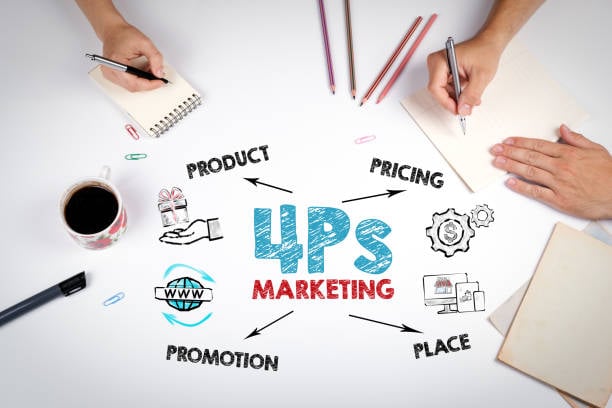February 28, 2022
 by AbdulGaniy Shehu / February 28, 2022
by AbdulGaniy Shehu / February 28, 2022

Marketing a business goes beyond advertising.
While advertising is important, you need to consider various other factors to convince prospects that your product or service is exactly what they need.
The 4 Ps of marketing - product, price, place, and promotion - also known as the marketing mix, is a popular marketing concept essential to ensure any business’ success.
This idea dates back to the 1940s, when Neil H. Borden, Professor of Advertising at the Harvard Graduate School of Business Administration, coined the term “marketing mix”.
Borden identified the 12 components of the marketing mix:
Later, in 1960, Edmund Jerome McCarthy, an American professor and author, developed the concept of the 4Ps of marketing in his book "Basic Marketing: A Marketing Strategy Planning Approach".
He summarized the 4 Ps as follows:
McCarthy published his book 50 years ago, but many marketers today rely on his approach to grow their businesses and train their teams.
A product is a value your company creates and what people pay you for. It can be tangible (like goods) or intangible (like consulting services).
A product is the most important part of the marketing mix. Without it, you have nothing to sell. Consumers today have countless options to choose from. So if your product isn’t noticed, it’ll most likely lose to another competitor.
The 4 Ps of marketing emphasize creating a unique product. This allows you to stand out against competitors and get customers to trust you.
If you want people to use your product, create something they love, and stand a better chance of competing.
So, how do you build a great product?
Former Evernote CEO Phil Libin highlighted two characteristics of great products.
Apple, the first publicly-traded company to reach $1 trillion, is an example of a great product.
One of the things that made their product stand out was that the company's founders, Steve Jobs and Steve Wozniak, set out to make computers user-friendly. This vision was and still is at the company’s heart and has distinguished it despite the intense competition in the technology industry.
Building a great product is good. Guess what’s better? A product that the market actually wants.
Simply put, if no one’s interested in your product, it won’t stand the test of time, no matter how great it is.
This is why performing in-depth market or user research before building any product is important. Proper preparations help you know what people want and don’t want.
If you want to go after a specific market, you can create an online survey to see if your target audience is interested in your product. This will help you identify pain points and know if the product you have in mind will solve them.
Let's say you want to build a team collaboration software for B2B offshore development agencies. Instead of directly building the minimum viable product (MVP), create a survey targeting your ideal audience. You can ask them various questions to confirm if you should proceed with a specific idea.
Another way to know if your product is in demand is to look at how it’s trending online. Here’s how a free tool like Google Trends can help you.
Source: Google Trends
As you can see, searches related to remote work have been growing steadily in the last five years. This shows that a remote-work product will most likely perform well in the market.
The price can be defined as how you capture your product’s value. This is simply the amount your product or service is worth and what the market is willing to pay for it.
While pricing seems simple on the surface, it’s difficult to estimate. As a marketer, you want to choose a price that’s attractive to your consumers, generates sales, and ensures your business is profitable.
Conduct audience analysis. The demographics and your audience's perception of your product also affect pricing. For example, if you run B2C software for college students, you’ll likely charge a lower price. Alternatively, if you offer B2B software for enterprise companies, you set a premium price for it.
If you charge college students a higher price, chances are they won’t go for it. They may not take you seriously if you charge enterprises a cheaper price.
When pricing your product, you don’t want to underprice yourself and end up with less profit. Also, you don’t want to overprice your product and chase customers away.
Here are some things to keep in mind so that your pricing best suits the product.
Before setting a price, you need to learn more about your industry. Check your competitors' prices and how they change over time. You should also understand what your target audience thinks about your product.
You need to reason out before you price your product. Are you looking to penetrate a competitive market or establish yourself as an industry leader?
If you’re new to an industry, starting with a low-pricing strategy might make more sense. However, if you’re selling a premium product, a higher price might appeal more to your target audience.
Some products serve one single audience persona; others work for different audiences. If you can create different audience segments, that could help you create pricing that resonates with each of them.
You incur direct and indirect costs when creating a product. Before determining your price, make sure that it covers these costs. That way, you won’t run at a loss.
Let's say you run a web development agency, and it costs you around $499 to design a WordPress website from scratch. This includes the hosting fee, development costs, hiring costs, etc. To break even, your pricing must be above $499. Else, you would be running your agency at a loss.
Aside from the direct and indirect costs, other factors might affect your pricing as well. For example, paying a value-added tax (VAT) for the end product will influence your pricing.
Confused about the pricing strategy for your product?
Here are different pricing strategies available and how to use them for different types of business.
|
|
Pricing Strategy |
What it Means |
When to Use |
|
1. |
Penetration pricing |
Setting up a low price to generate sales and gain market share |
When entering a new market with many competitors |
|
2. |
Skimming pricing |
Start with an initial high price and reduce it over time |
When introducing a product to different market segments |
|
3. |
Competitor-based pricing |
Fixing a price based on what your competitors are charging |
When you’re in a competitive niche with lots of customer options |
|
4. |
Product line pricing |
Setting different prices for products in the same range |
When similar products have different features |
|
5. |
Bundle pricing |
Bundling a group of products together and selling them at a reduced price |
When offering a discount or promo for your audience |
|
6. |
Psychological pricing |
Making a small change to the pricing makes customers think that it’s lower |
When you want customers to think they’re getting the best bargain |
|
7. |
Premium pricing |
Setting a high price for your product or service |
To establish your product as exclusive and of high quality |
|
8. |
Optional pricing |
Add optional extra items and bonuses for the customer |
To make a product attractive to your target audience |
|
9. |
Cost-based pricing |
Determine the exact cost for production and add a markup as profit |
When you’re in an unpredictable industry or market |
|
10. |
Cost-plus pricing |
Add a percentage of the profit to the product’s cost |
When focused on the profit that the company can make |
If no one knows about your product, they won’t use or recommend it to others. This is where place, the third p of marketing, comes into play. The place is the location where you deliver value to your target audience. It’s also where your target audience hangs out.
If you’re a local business serving people who live in a particular city, your local marketing will be limited to that city alone. So, a local radio station that most people in your city listen to might work well for you in this case.
With the internet, a lot of activities have gone online. So, the best way to find your target audience is online.
The first thing you need to do is determine your target audience. That's because if they're not where you're looking, it might be difficult to sell to them. The best way to find out is to reach out to your new and existing customers to get the information from them.
Depending on your type of business, here are a few places to convey the value of your product to your audience.
Social media continues to grow every day. There are now around 4.55 billion social media users in the world. This means that social media is a great place to reach your target audience faster.
When using social media, you should understand the demographics and behavior of your target audience. If you want to target C-level B2B executives, LinkedIn might make more sense than Instagram. If your audience is mostly Gen Z who are still in college, Tiktok might work better for them.
Online communities and forums are great, too, depending on the type of business you run. Take Reddit as an example. The gaming subreddit has around 31 million members, while the technology subreddit has more than 11 million members.
If you have a technology-related product or service, these are great places to turn to. That's because most of the people on these subreddits are also interested in learning from others and discussing these topics.
Other online communities to leverage are Facebook groups, LinkedIn groups, Slack communities, Quora spaces, and so on.
Most users want to read other people's experiences about a product or service before purchasing. For this reason, review websites are a great way to convey your product’s value to your target audience.
If you're a local business owner, you can create a profile on Yelp to showcase your business to your audience. If you have a software or services company, you can use the power of G2 to show prospects what customers think of your product.
Apart from helping you collect reviews and testimonials from existing customers, review websites also make your product or service discoverable in the search engines.
The final and most popular marketing mix is promotion. This is simply how you communicate the value of your product or service to your target audience.
Promoting your value is important because your audience’s perception determines whether or not they want to use your product or service. One of the most effective ways to communicate this is by talking about your product.
While many business owners are afraid to promote their products because they don't want to sound salesy. However, if you have a great product and aren't actively promoting it to your target audience, you're doing them a disservice.
Here’s a quick example.
Let's say you're a software company competing in a crowded niche. One of the ways to help your audience discover your product is to use a pain-point content marketing strategy.
This way, you can show your target group why they should use your product over other options. You can do this by creating a comparison post, alternative page, best {X} products page, and more. And you have a better chance of converting people who stumble across these pages into user sign-ups and paying customers for your SaaS.
That means if you don't tell anyone about your product or show them why it's better than other competitors, they won't find or use it.
The best way to promote your business is to understand your audience's pain points and create content that helps solve these problems.
For example, if your target audience is CMOs who want their marketing teams to be more productive, creating a content piece that shows them tips and tools for improved productivity works wonders. And if you have a relevant service or product to solve this problem, you can mention that as well.
The truth is, when you help people and add value to their lives, they pay attention to you and are likely to pay you to solve their problems.
Below are some promotion strategies you can leverage for your business.
One of the most reliable and proven ways to promote a business online is SEO. It allows you to optimize certain web pages to rank in search engines, especially Google.
SEO determines how your page or website appears when someone searches for keywords relevant to your product or service. This is effective as many people search on Google every day. In fact, Google processes over 4 billion searches per day.
The downside of SEO is that it usually takes a long time to deliver results that amplify over time. A good example of a company leveraging SEO to promote its business over the years is HubSpot. HubSpot's blog receives about 8 million visitors from organic traffic each month and ranks for about 3 million keywords.
Hosting webinars is an effective way to promote your business online. This works really well because it involves interacting live with prospects and customers.
Seventy-six percent of businesses believe hosting webinars helps them reach more leads, and 69% believe it has helped them scale their marketing efforts.
The disadvantage of webinars is that it takes a lot of resources and time to create one. If you're not good with videos, it might not work well for you. The advantage over other advertising channels is that it leads to more conversions. For example, if someone attends a webinar for 45 to 60 minutes, they’re more likely to be convinced to use your product or service.
One company that has harnessed the power of webinar tools to boost its business is Monday. They have a daily webinar hub on their website. You can register for a live and on-demand webinar from the company. They also have webinars in other languages to cater to their non-English speaking audience.
Google Business Profile (formerly Google My Business), is another effective promotional strategy for business owners. This is highly beneficial for local businesses serving a specific audience in a city, state, or county.
Anyone with a Gmail account can easily create a Google listing. Once you create and optimize this profile, your business shows up on Google when someone searches for it near you.
With this tool, you can know how customers found your business and what actions they took before contacting you. You can also interact with them, share images of your products, and easily get reviews.
The benefit of using this free tool is that it's easy to set up. However, if you're in a location with a lot of small businesses, it can be difficult to get a foothold quickly.
Paid advertising is another great way to promote a business online. When you advertise, you reach your audience right where they are and convince them to use your product or service.
You can use various advertising channels to promote a business, including:
With paid advertising, you can reach your target audience quickly and, in most cases, see ROI immediately. However, these don’t add up. Once you stop promoting, you stop getting results.
About 4.3 billion people around the world use email. This shows that email is a huge promotional channel any business can use. It's a personal communication channel for most people, so they check it regularly.
You may see excellent results by creating valuable and helpful content for your audience and delivering it via email.
When the 4 Ps of marketing work together, it becomes easier to deliver predictable results for your business. You need to be consistent with your marketing across the board. Otherwise, you risk losing your audience’s trust.
For example, if you sell a high-quality B2B product, promoting it on TikTok can bring poor results. This is because a B2B audience may not even know a platform like TikTok exists, so they don't go there.
Also, if you’re just starting in an industry, you may need to spend more time promoting your products or services. This may not be the case if you are a market leader in your niche.
The illustration below shows how to apply the 4 Ps of marketing in any business.
Source: BBC
To grow a business successfully, you need the 4 Ps of marketing. First, you should have a clear idea of what you’re selling and why it’s different from anything else out there.
Here are some fundamental questions to ask:
Second, you need to set the prices for your product. This must match the type of product you’re selling.
Additionally, determine where to find your target audience and convey your message and value proposition via those channels.
Ask:
Finally, promote your product to your target audience.
Find out:
Building a business from scratch is difficult. You need to create a great product that can successfully compete in your niche, set a price point that resonates with your target audience, and grow your business. Additionally, you should also identify places where your target audience hangs out and deliver the expected value.
Leverage advanced marketing strategies to predictably and successfully develop a business in any niche.
AbdulGaniy Shehu runs Your Content Mart, a results-driven content marketing agency that helps B2B SaaS companies generate qualified traffic and increase user sign-ups. His work has been featured on Entrepreneur, Moz, Smart Insights, Hackernoon, and more.
You've come up with a fresh business idea, created a new product, or rebranded an old one.
 by Anna Konovalova
by Anna Konovalova
Companies put a lot of effort into marketing their brands.
 by Sujan Patel
by Sujan Patel
In today's data-driven landscape, random promotions simply don't cut it.
 by Jordan Wahl
by Jordan Wahl
You've come up with a fresh business idea, created a new product, or rebranded an old one.
 by Anna Konovalova
by Anna Konovalova
Companies put a lot of effort into marketing their brands.
 by Sujan Patel
by Sujan Patel


